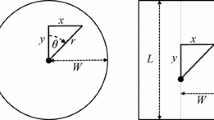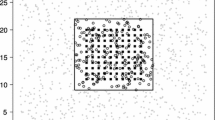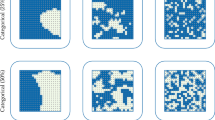Abstract
Most capture–recapture studies are inherently spatial in nature, with capture probabilities depending on the location of traps relative to animals. The spatial component of the studies has until recently, however, not been incorporated in statistical capture–recapture models. This paper reviews capture–recapture models that do include an explicit spatial component. This is done in a non-technical way, omitting much of the algebraic detail and focussing on the model formulation rather than on the estimation methods (which include inverse prediction, maximum likelihood and Bayesian methods). One can view spatially explicit capture–recapture (SECR) models as an endpoint of a series of spatial sampling models, starting with circular plot survey models and moving through conventional distance sampling models, with and without measurement errors, through mark–recapture distance sampling (MRDS) models. This paper attempts a synthesis of these models in what I hope is a style accessible to non-specialists, placing SECR models in the context of other spatial sampling models.














Similar content being viewed by others
Notes
Note that the “effective sample area” of Royle et al. (2009a) is not the same thing as the effective sample area of this paper. Their effective sample area is the effective area within which animals might be captured—analogous to the area of the searched region in the SECR movement model but excluding the p(x) of that model.
References
Alpizar-Jara R (1997) Assessing assumption violation in line transect sampling. PhD thesis, North Carolina State University, Raleigh
Borchers DL (1996) Line transect estimation with uncertain detection on the trackline. PhD thesis, University of Cape Town
Borchers DL, Efford MG (2008) Spatially explicit maximum likelihood methods for capture–recapture studies. Biometrics 64:377–385
Borchers DL, Zucchini W, Fewster RM (1998) Mark-recapture models for line transect surveys. Biometrics 54:1207–1220
Borchers DL, Buckland ST, Zucchini W (2002) Estimating animal abundance: closed populations. Springer, London
Borchers DL, Pike D, Gunnlaugsson T, Vikingsson GA (2009) Minke whale abundance estimation from the NASS 1987 and 2001 cue counting surveys taking account of distance estimation errors. North Atlantic Marine Mammal Commission Special Issue 7: North Atlantic Sightings Surveys (1987–2001), pp 95–110
Borchers DL, Marques TA, Gunlaugsson T, Jupp P (2010) Estimating distance sampling detection functions when distances are measured with errors. J Agric Biol Environ Stat. doi:https://doi.org/10.1007/s13253-010-0021-y
Buckland ST, Anderson DR, Burnham KP, Laake JL, Borchers DL, Thomas L (2001) Introduction to distance sampling: estimating abundance of biological populations. Oxford University Press, Oxford
Burnham KP, Overton WS (1978) Estimation of the size of a closed population when capture probabilities vary among animals. Biometrika 65:625–633
Chen SX (1998) Measurement errors in line transect surveys. Biometrics 54:899–908
Chen SX, Cowling A (2001) Measurement errors in line transect sampling where detectability varies with distance and size. Biometrics 57:732–742
Dawson DK, Efford MG (2009) Bird population density estimated from acoustic signals. J Appl Ecol 46:1201–1209
Dorazio RM, Royle JA (2003) Mixture models for estimating the size of a closed population when capture rates vary among individuals. Biometrics 59:351–364
Efford MG (2004) Density estimation in live-trapping studies. Oikos 106:598–610
Efford MG, Dawson DK, Robbins CS (2004) DENSITY: software for analysing capture–recapture data from passive detector arrays. Anim Biodivers Conserv 27:217–228
Efford MG, Warburton B, Coleman MC, Barker RJ (2005) A field test of two methods for density estimation. Wildl Soc Bull 33:731–738
Efford MG, Borchers DL, Byrom AE (2009a) Density estimation by spatially explicit capture–recapture: likelihood-based methods. In: Thompson DL, Cooch EG, Conroy MJ (eds) Modeling demographic processes in marked populations. Springer, New York, pp 255–269
Efford MG, Dawson DK, Borchers DL (2009b) Population density estimated from locations of individuals on a passive detector array. Ecology 90:2676–2682
Hiby L, Ward A, Lovell P (1989) Analysis of the North Atlantic sightings survey 1987: aerial survey results. Rep Int Whaling Comm 39:447–455
Kissling ML, Garton EO, Handel CM (2006) Estimating detection probability and density from point-count surveys: a combination of distance and double-observer sampling. Auk 123:735–752
Manly B, McDonald L, Garner G (1996) Maximum likelihood estimation for the double-count method with independent observers. J Agric Biol Environ Stat 1:170–189
Marques TA (2004) Predicting and correcting bias caused by measurement error in line transect sampling using multiplicative error models. Biometrics 60:757–763
Marques TA, Thomas L, Martin SW, Mellinger DK, Jarvis S, Morrissey RP, Ciminello C, DiMarzio N (2010) Spatially explicit capture recapture methods to estimate minke whale abundance from data collected at bottom mounted hydrophones. J Ornithol. doi:https://doi.org/10.1007/s10336-010-0535-7
Norris JL, Pollock KH (1996) Nonparametric MLE under two closed capture–recapture models with heterogeneity. Biometrics 52:639–649
Obbard ME, Howe EJ, Kyle C (2010) Empirical comparison of density estimates for large carnivores. J Appl Ecol 47:76–84
Pledger S (2000) Unified maximum likelihood estimates for closed capture–recapture models using mixtures. Biometrics 56:434–442
Royle JA, Dorazio RM (2008) Hierarchical modeling and inference in ecology. Academic, London
Royle JA, Young KV (2008) A hierarchical model for spatial capture–recapture data. Ecology 89:2281–2289
Royle JA, Nichols JD, Karanth KU, Gopalaswamy AM (2009a) A hierarchical model for estimating density in camera-trap studies. J Appl Ecol 46:118–127
Royle JA, Karanth KU, Gopalaswamy AM, Kumar NS (2009b) Bayesian inference in camera-trapping studies for a class of spatial capture–recapture models. Ecology 90:3233–3244
Acknowledgments
I would like to thank Andy Royle for inviting me to present this work at the 2009 EURING Meeting, Tiago Marques and Len Thomas for useful feedback on an earlier draft, which led to a much improved manuscript, and to the anonymous reviewers for making suggestions that improved the accessibility and readability of the manuscript.
Author information
Authors and Affiliations
Corresponding author
Additional information
Communicated by M. Schaub.
Rights and permissions
About this article
Cite this article
Borchers, D. A non-technical overview of spatially explicit capture–recapture models. J Ornithol 152 (Suppl 2), 435–444 (2012). https://doi.org/10.1007/s10336-010-0583-z
Received:
Revised:
Accepted:
Published:
Issue Date:
DOI: https://doi.org/10.1007/s10336-010-0583-z




